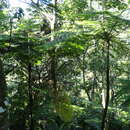en
names in breadcrumbs


Cyathea arborea (vernacular English: West Indian treefern,[1] vernacular Spanish: helecho gigante or palo camarón) is a plant of the family Cyatheaceae in the order Cyatheales.
This species of tree fern is native to the Caribbean, including Cuba, Jamaica, Hispaniola (Haiti and the Dominican Republic), the El Yunque National Forest in Puerto Rico, and the Lesser Antilles from the Virgin Islands to Tobago.
This perennial fern can reach a height of 27 feet. It has a thornless trunk measuring from 3 to 5 inches. The surface of the trunk is hard with a soft, white core. Its crown has 10 or more leaves in the form of a fan. When they are young, its leaves are rolled up and as they grow they unroll until they reach their horizontal position. As with all ferns,[2] species of the Cyatheaceae reproduce from spores. These are produced in small sporangia on the bottom side of their leaves.[3][4]
Tree ferns as a group are mostly found it wet tropical forest, with Cyathea arborea itself being found in locations such as such as Puerto Rican moist forests and Hispaniolan moist forests. While they can grow under a canopy, it is likely that natural disturbances such as landslides and hurricanes create gaps in the forest canopy that allow them to regenerate.[5]
Cyathea arborea (vernacular English: West Indian treefern, vernacular Spanish: helecho gigante or palo camarón) is a plant of the family Cyatheaceae in the order Cyatheales.
El helecho gigante o palo camarón (Cyathea arborea) es una planta de la familia de las ciatáceas.
Helecho perennifolio que puede alcanzar 9 m de altura, con tronco marrón de 7,6 a 12,5 cm, delgado, sin espinas y corona de diez o más hojas (frondas) de helecho en forma de abanico. Las frondas cuando nuevas están enrolladas, estas se desarrollan hasta quedar en posición horizontal. El tronco no tiene espinas y su corteza es dura con un corazón blanco y suave. Las ciatáceas no tienen flores, semillas ni frutos, para su reproducción tienen unas masas redondas debajo de las hojas que producen esporas polvorientas. El tronco no se divide en corteza y madera y no crece en diámetro. Este tiene una cubierta negra exterior dura y delgada y en el centro es blanco con mazos que dan rigidez y sirven para conducir líquidos[1][2]
Los helechos gigantes se encuentran en las planicies y los bosques de altura en todas las Antillas como pequeño árbol del sotobosque.
Los caribes usaban los troncos ahuecados para conservar y cargar las brasas, manteniéndolas durante horas sin humo ni llamas[1]
Cocción de zumo de los tallos de las hojas se usa para enfermedades de mujeres y aumentar su fertilidad. Baba de tallo sirve contra paludismo, fiebre, para el hígado y bazo, enfermedades venéreas, próstata, Leishmaniasis, estómago, corazón y tuberculosis. Infusión de la corteza se aplica para bronquitis y otras afecciones pulmonares.[3]
El helecho gigante o palo camarón (Cyathea arborea) es una planta de la familia de las ciatáceas.
Cyathea arborea est une espèce de fougère arborescente originaire d'Amérique du Sud et des Antilles.
Cette fougère arborescente peut atteindre 9 mètres de haut avec un tronc de 12 centimètres de diamètre, sans épines. Les feuilles sont horizontales.
Les Cyathea arborea forment des bosquets dans les plaines d'altitude des Antilles, du Venezuela jusqu'en Équateur.
Cyathea arborea à Porto Rico
Cyathea arborea sur la Soufrière (Guadeloupe)
Cyathea arborea est une espèce de fougère arborescente originaire d'Amérique du Sud et des Antilles.
Cyathea arborea là một loài dương xỉ trong họ Cyatheaceae. Loài này được L. Sm. mô tả khoa học đầu tiên năm 1793.[1]
Cyathea arborea là một loài dương xỉ trong họ Cyatheaceae. Loài này được L. Sm. mô tả khoa học đầu tiên năm 1793.